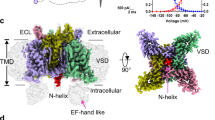Abstract
THE action potential evoked from an artificially produced excitable node of isolated crab axon membrane1 shows similar changes to those described for the isolated toad node2, when currents are applied during the action potential itself. The rising phase of the action potential can be modified only by very considerable anodal currents (some 40 times rheobase), but the repolarization phase shows changes when weak currents of either polarity are applied (Fig. 1). Repolarization is delayed by cathodal current and is hastened by anodal current, when these are applied during the falling phase of the action potential. The divergence of the voltage profile of repolarization, produced by a constant current pulse of either polarity, is greater the later it is applied, as would be expected from the form of the change in membrane resistance that accompanies the voltage change of the action potential. The changes in the rate of repolarization are proportional to the strength of the applied current and its duration, so that complete repolarization can be achieved with strong anodal current, that is, the later phase of the action potential can be abolished.
This is a preview of subscription content, access via your institution
Access options
Subscribe to this journal
Receive 51 print issues and online access
$199.00 per year
only $3.90 per issue
Buy this article
- Purchase on Springer Link
- Instant access to full article PDF
Prices may be subject to local taxes which are calculated during checkout
Similar content being viewed by others
References
Chapman, R. A., Nature, 199, 701 (1963).
Tasaki, I., J. Gen. Physiol., 39, 377 (1956).
Hodgkin, A. L., J. Physiol., 170, 165 (1948).
Fuortes, M. G. F., and Mantegazzini, F., J. Gen. Physiol., 45, 1163 (1962).
Huxley, A. F., Ann. N.Y. Acad. Sci., 81, 221 (1959).
Author information
Authors and Affiliations
Rights and permissions
About this article
Cite this article
CHAPMAN, R. Lability of the Action Potential and the Recovery Cycle from Isolated Motor Axons of the Crab, Carcinus. Nature 203, 872–873 (1964). https://doi.org/10.1038/203872a0
Issue Date:
DOI: https://doi.org/10.1038/203872a0
Comments
By submitting a comment you agree to abide by our Terms and Community Guidelines. If you find something abusive or that does not comply with our terms or guidelines please flag it as inappropriate.



